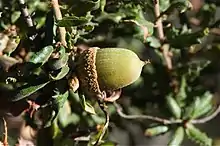Quercus dumosa
Quercus dumosa is a species of plant in the family Fagaceae, belonging to the white oak section of the oak genus (Quercus).[2] This tree goes by the common names coastal sage scrub oak[3] and Nuttall's scrub oak.[4]
| Coastal sage scrub oak | |
|---|---|
 | |
| Scientific classification | |
| Kingdom: | Plantae |
| Clade: | Tracheophytes |
| Clade: | Angiosperms |
| Clade: | Eudicots |
| Clade: | Rosids |
| Order: | Fagales |
| Family: | Fagaceae |
| Genus: | Quercus |
| Subgenus: | Quercus subg. Quercus |
| Section: | Quercus sect. Quercus |
| Species: | Q. dumosa |
| Binomial name | |
| Quercus dumosa | |
Distribution
Quercus dumosa is found in Baja California and in California.[5][6] It is threatened by habitat loss.[7] The species lends its name to the plant community called the "Quercus dumosa chaparral", in which Coastal sage scrub oak and toyon often co-dominate in chaparral.[8]
Botanical characteristics
Quercus dumosa is an evergreen shrub growing 1 to 3 meters (40-120 inches or 3.3-10.0 feet) tall from a large, deep root network. The leaves have spiny or toothed edges. The fruit is an acorn up to 1.5 centimeters (0.6 inches) wide. Some individuals produce large crops of acorns, and some produce very few fruits. The acorns are dispersed by gravity as they fall from the tree, and by animals that pick them up, such as squirrels and jays. Animals eat them immediately or cache them for later. The acorns tend to germinate easily. Reproduction via seed generally occurs only in very moist years.[4][9]
Allergenicity
Coastal Sage Scrub Oak (Quercus dumosa) is a severe allergen. Pollination: Occurs in following seasons depending on latitude and elevation: Spring. [10]
Ecology
Quercus dumosa grows primarily in sandy soils such as sandstone near the coast. Its habitat is often chaparral. This oak sprouts vigorously from its stump and root crown after wildfire and develops a large canopy within a few years after a fire event. It sometimes co-dominates with Ceanothus species as early as four years after a fire. This oak also does well in the absence of fire.[4]
See also
References
- Beckman, E. (2017). "Quercus dumosa". IUCN Red List of Threatened Species. 2017: e.T34662A2853964. doi:10.2305/IUCN.UK.2017-2.RLTS.T34662A2853964.en.
- Nixon, Kevin C.; Muller, Cornelius H. (1997). "Quercus sect. Quercus". In Flora of North America Editorial Committee (ed.). Flora of North America North of Mexico (FNA). 3. New York and Oxford – via eFloras.org, Missouri Botanical Garden, St. Louis, MO & Harvard University Herbaria, Cambridge, MA.
- "Quercus dumosa". Natural Resources Conservation Service PLANTS Database. USDA.
- Fryer, Janet L. (2012). "Quercus berberidifolia, Q. dumosa". Fire Effects Information System (FEIS). US Department of Agriculture (USDA), Forest Service (USFS), Rocky Mountain Research Station, Fire Sciences Laboratory – via https://www.feis-crs.org/feis/.
- "Quercus dumosa". Calflora: Information on California plants for education, research and conservation, with data contributed by public and private institutions and individuals, including the Consortium of California Herbaria. Berkeley, California: The Calflora Database – via www.calflora.org.
- SEINet, Southwestern biodiversity, Arizona chapter
- K. Nixon et al. (1998) IUCN Red List of Threatened Species: Quercus dumosa . accessed 17 January 2012.
- C. Michael Hogan (2008) Toyon: Heteromeles arbutifolia Archived September 6, 2009, at the Wayback Machine, GlobalTwitcher.com, ed. N. Stromberg.
- Nixon, Kevin C. (1997). "Quercus dumosa". In Flora of North America Editorial Committee (ed.). Flora of North America North of Mexico (FNA). 3. New York and Oxford – via eFloras.org, Missouri Botanical Garden, St. Louis, MO & Harvard University Herbaria, Cambridge, MA.
- http://www.pollenlibrary.com/Local/Specie/Quercus+dumosa/in/Santa%20clara%20County/CA/
External links
| Wikimedia Commons has media related to Quercus dumosa. |
- Jepson Manual treatment
- Quercus dumosa in the CalPhotos Photo Database, University of California, Berkeley
